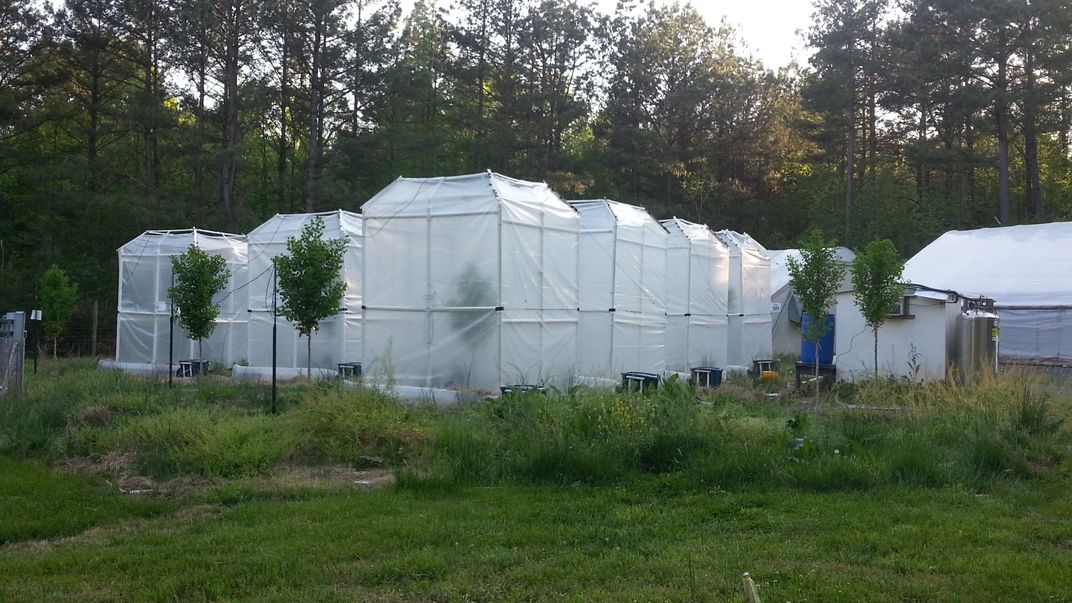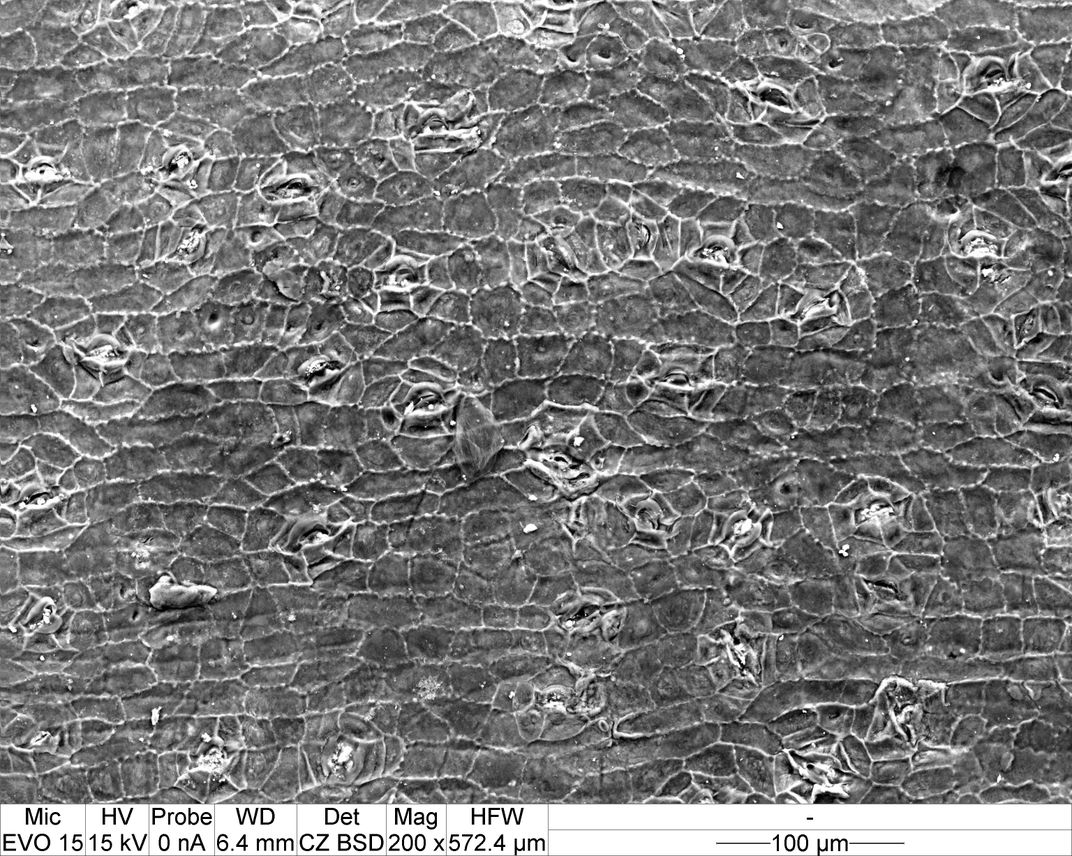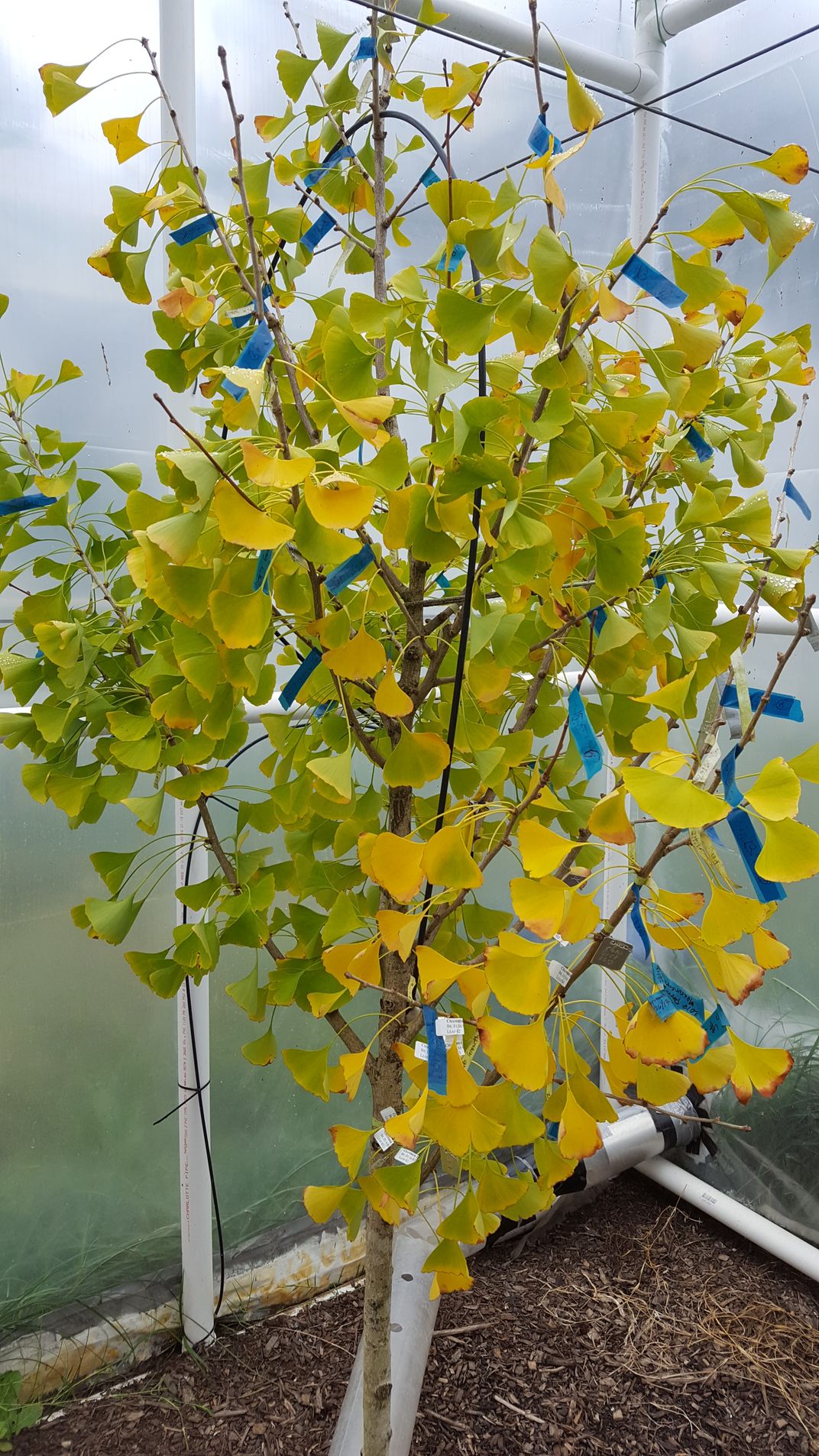The next time you venture into the great outdoors, keep an eye out for Ginkgo biloba trees, which can be easily identified by their distinctive fan-shaped leaves. If you find one—and you likely will, as the native Chinese plant is now ubiquitious in the United States—take a moment to pluck a few leaves, snap some photographs of the scene, and record your observations via the iNaturalist mobile app. Then, package your sample in an envelope, drop it into the mailbox, and give yourself a pat on the back. Congratulations: You’ve just become a citizen scientist, helping researchers at the Smithsonian’s National Museum of Natural History use ginkgo leaves to study the past, present and future of climate change.
Perhaps best known for its pungent smell and medicinal properties, ginkgo actually boasts an impressive backstory. As the online portal for the museum’s Fossil Atmospheres project explains, the conifer plant (meaning it has seeds but doesn’t produce flowers) arrived on the scene more than 200 million years ago. Surviving three mass extinctions, including the one that killed the dinosaurs, ginkgo has retained a remarkably similar appearance throughout its time on Earth. This characteristic makes it possible for scientists to easily compare modern specimens with fossils dating to the distant past—a practice that could help researchers assess how the planet’s atmosphere has changed over time, as well as predict what effect future climate shifts will have on Earth’s living creatures.
Rich Barclay, the paleobotanist who leads Fossil Atmospheres, says the project consists of two main parts: an experiment based out of the Smithsonian Environmental Research Center in Edgewater, Maryland, and a multi-phase citizen science initiative. Per a Smithsonian Voices blog post penned by Barclay and Laura Soul, the museum’s Deep Time Science Education Specialist, in June 2017, the experimental side of the research revolves around a grove of 10-foot-tall ginkgo trees being grown at carbon dioxide concentrations ranging from 400 parts per million (ppm), or the level found in the atmosphere today, to 1,000 ppm, a ratio last seen when Earth’s climate was so warm that there were no polar ice caps.

The citizen science component, on the other hand, began with crowdsourced stomatal counting—a plant’s stomatal index reflects carbon dioxide concentration at the time of its growth, enabling scientists to gauge the conditions in which a specimen developed—and is set to continue with a newly launched leaf survey. This latest phase, running for the entire month of August, asks science enthusiasts from across the country to send in ginkgo leaves from their local communities. These samples will be used to paint a clearer picture of how a plant’s features reflect the environment in which it grows, providing insights on contemporary climate that can then be applied to prehistoric climates, as represented by well-preserved ginkgo fossils.
Soul, who leads the educational side of Fossil Atmospheres, explains, “We can't go out and get leaves from every state in North America, but the public can. . . and that's why citizen science performs [such] a vital role in what we’re doing.”
She adds, “[Citizen scientists] are enabling the project to have a much broader scope and [helping researchers] answer questions that we wouldn't be able to answer otherwise.”
To contribute, interested parties must follow a detailed set of instructions outlining the process of obtaining, recording and submitting specimens. Be sure to follow every step, from identifying the sex of a chosen ginkgo tree to noting its exact location, uploading photos and observations to the iNaturalist app, and properly packaging the leaves, or else the scientists will not be able to use your sample. For more details, visit the project’s website or email [email protected].
Attention nature-lovers, the @smithsonian needs your help in a #CitizenScience project! Gather leaves from Ginkgo trees, mail them to our @FossilAt research team, and advance our understanding of Earth’s climate history! #FossilFriday https://t.co/5Ay7g58hUu pic.twitter.com/oePfpC1vQk
— Smithsonian's NMNH (@NMNH) August 2, 2019
By restricting the time period in which samples are collected, as well as outlining specific instructions, Barclay says the team will be able to reduce the number of variables affecting stomatal count down to geographic range and environmental factors such as temperature, rainfall, elevation and latitude. Ultimately, data garnered from these public contributions will play a key role in published scientific research. Even if specimens aren’t used for Fossil Atmospheres specifically, Soul points out that they will be permanently accessioned into the Smithsonian’s collections: She notes, “Future scientists will be able to use them to answer questions that we haven’t even thought of yet.”
The exact science behind the project largely comes down to stomatal index, which serves as a climate proxy, or means of reconstruction, for past carbon dioxide concentration. In layman’s terms, stomata are tiny openings on leaves’ surfaces that let in CO2 but expel oxygen and water. Stomatal index refers to the optimal number of stomatal pores needed to facilitate this exchange and is determined by an array of environmental factors, chief among them the level of carbon dioxide in the atmosphere.
As Barclay explains, low stomatal numbers tend to correspond with high CO2, while high stomatal numbers correlate with low CO2. But while researchers “know there’s a strong relationship between decreasing number of pores. . . and increasing CO2,” previous studies have failed to fully quantify this dynamic.
“We knew we needed to redo [the research], and we wanted to do it in a more realistic way,” the paleobotanist says. “We moved to this scenario where we’re actually growing trees under elevated conditions, . . . pushing the plants to higher CO2 concentrations than [have] ever been studied.”

According to Barclay, Fossil Atmospheres is unique in both its scale and level of citizen science involvement. In addition to the leaf survey, the volunteer side of the project involves counting stomatal pores captured in images of modern and fossilized leaves. This task is decidedly more difficult than simply collecting and cataloguing leaves, but the campaign’s Zooniverse page offers tips, tutorials and practice rounds for those willing to give it a try. (For what it’s worth, more than 3,300 participants have contributed 31,000 classifications to date.) Samples collected via the leaf survey will later be imaged and added to the counting page.
“Some people are excellent at [counting], and some people struggle a bit more,” Soul observes. Since each image is presented to multiple volunteers, however, the team has found that maximizing participation usually yields an accurate answer.
In Barclay’s view, citizen science benefits everyone involved. Volunteers have an opportunity to contribute valuable scientific research and learn more about the topic at hand, while experts gain a trove of usable data. With more individuals collecting leaves and counting stomatal pores, the project can be completed in a reasonable amount of time—namely, within the next several years.
Fossil Atmospheres’ ultimate goal is to determine the relationship between carbon dioxide and stomatal index. By doing so, Barclay and Soul write in Smithsonian Voices, “We should be able to pick up a fossil ginkgo leaf and know the composition of the air in which it grew.” At the same time, the researchers hope to use their findings to answer a key question about the future: “As we humans add carbon dioxide to the atmosphere, how warm will the planet get?” The answer, according to the pair, lies in the past, locked in the minute nooks and crannies of ginkgo leaves’ surfaces.
“The real benefit [for volunteers] is to participate in a project that's actually answering useful questions about our changing climate, which is one of the most pressing issues that we're facing at the moment,” Soul concludes. “This kind of research. . . is going to be vital moving forward.”

/https://tf-cmsv2-smithsonianmag-media.s3.amazonaws.com/filer/1e/47/1e477fbb-4854-4938-91c3-d1fd1718ab31/img_0984.jpg)

/https://tf-cmsv2-smithsonianmag-media.s3.amazonaws.com/filer/77/ba/77baf163-49b7-47c3-b0e6-5f1b1c2f6438/20171111_103638.jpg)
/https://tf-cmsv2-smithsonianmag-media.s3.amazonaws.com/accounts/headshot/mellon.png)
/https://tf-cmsv2-smithsonianmag-media.s3.amazonaws.com/accounts/headshot/mellon.png)